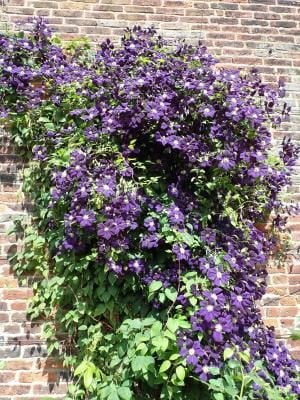What is Clematis Wilt?
If you grow Clematis, at some point you will encounter Clematis Wilt.
Clematis Wilt strikes is dramatic, and almost overnight all or parts of the plant will go brown, and collapse.
The plant will look as if it is very dry, all brown and droopy, but in fact, it is the dreaded wilt. The general view is that Clematis wilt is caused by a fungus ( Calophoma clematidina [syn Phoma clematidina, Ascochyta clematidina]). It is also true to say that scientists are not 100% sure that this is the cause, as Clematis wilt also seems to occur where there is no evidence of fungus.
In the image wilt has attacked part of the plant but not totally affected it and some flowers are present but the plant looks shabby. Clematis wilt may or may not affect the plant the following year. More often than not, if the weather conditions are different, the wilt may not appear the next year. There may even be healthy shoots at the base of the plant if the wilt is not too widespread.
In these cases it is usually environmental causes which include how the Clematis has been planted, and it's growing environment, see below.
Whatever causes Clematis Wilt, what to do about it?
How to prevent Clematis wilt
To be clear, you cannot prevent Clematis wilt, but you can reduce the chances of it occurring.
First, there are some Clematis which have a greater resistance to Clematis Wilt. Clematis, which are more resistant to wilt, are C. Montana, Alpina, Orientalis, Viticellas Macropetala, and Tangutica (see Types of Clematis for illustrations of these types of Clematis.) Crocus have a selection of the more wilt resistant varities of Clematis.
How you plant a Clematis may also help to prevent Clematis wilt. It is important to plant Clematis deeply. The rule of thumb is to ensure the root ball is at least 5cms below the soil level. Deeper planting reduces the risk of wilt, aids root development and the Clematis will develop better roots and shoots from the base. How to plant Clematis information and video.
"Right plant Right place" will also give the Clematis the best chance of being healthy and fending off Clematis wilt. Clematis belongs to a group of plants which likes its roots in shade and its head in the sun. In addition, Clematis prefers fertile soil on the moist side. Given that Clematis prefers growing conditions which are moist, a good mulch around the roots is helpful and also physically shading the roots. It is possible to buy specifically manufactured clay pots to protect the roots, which can be expensive. An alternative is to use a spare slate taking care not to damage the root or stem. Alternatively, plant around the roots such as a large leafed Hosta to shade the roots.
It is also important to keep Clematis well watered, not just after planting, but during the summer, especially if it is dry. If Clematis become dry, it will cause stress to the plant and as a result become more prone to wilt.
There is no chemical control to prevent or cure wilt. All you can do if wilt strikes is to cut and prune off any affected stems and leaves. Remove all infected parts and clean the secateurs or cutters to ensure no cross infection.

It is very disheartening when wilt strikes. Often the Clematis is about to get into full swing with lots of buds and then starts to wilt. The good news is that often it will recover, but you have to be bold and remove all the infected parts.
Perceived garden wisdom is not to plant Clematis near a wall. This is because Clematis like a cooler root run, with moist shady soil, growing up a wall is a dry area. This image shows how fickle Clematis and gardening advice can be. Illustrated is a C. Jackmanii which is planted and growing up a wall with no signs of wilt. Any plant growing next to a wall will be a dry area, within a rain shadow and yet this mature Clematis looks splendid. So if your heart's desire is to have a lovely, large flowered clematis growing up a wall, and it has to be a late flowering variety, take a chance you may get lucky.
Even if you follow these recommendations, it is difficult to stop Clematis wilt, and sometimes it seems pretty random.
Last update 20.03.2023
